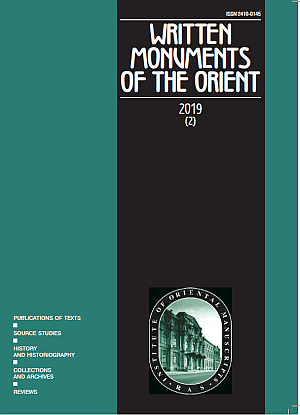卷 5, 编号 2 (2019)
- 年: 2019
- ##issue.datePublished##: 15.12.2019
- 文章: 6
- URL: https://journals.eco-vector.com/2410-0145/issue/view/1421
- DOI: https://doi.org/10.17816/wmo.52
Original Papers
On the History of the Formation and Processing of the Collection of the Tibetan Texts from Khara-Khoto Kept at the IOM, RAS
摘要
The Tibetan manuscripts and block prints from Khara-Khoto that were passed to the Asiatic Museum with other texts brought by P.K. Kozlov from his Mongolia and Sichuan Expedition have been insufficiently studied. Their processing was initiated in the second half of the 1960s and continued in the Post-Soviet period. The collection of the Tibetan Texts from Khara-Khoto, according to our analysis, included a number of documents from other sources. Trying to understand why it took place, we looked for and found some archival documents that shed light on the history of the formation of this collection and, simultaneously, helped to clarify some general issues concerning the fate of texts brought by P.K. Kozlov from Khara-Khoto. This paper presents the results of our study of the documents found in the St. Petersburg Branch of the Archives of the Russian Academy of Sciences, the Archives of the IOM, RAS, the Russian Ethnographic Museum and the Russian Geographic Society. The description of the events is divided into two parts: the first one reconstructs the chronology of the process of transferring manuscripts and block prints of P.K. Kozlov’s Expedition to the Asiatic Museum; the second one deals with the history of the processing of the Tibetan texts from Khara- Khoto starting from the 1920s and up to present, when the contents of the collection have been critically revised. The table that reflects the current state of the Collection of the Tibetan Texts from Khara-Khoto kept at the IOM, RAS is provided in the appendix.
 3-18
3-18


Old Uyghur Blockprint of Sitātapatrā Dhāraṇī in the Serindia Collection of the IOM, RAS
摘要
Sitātapatrā, referred to as ‘White Umbrella One’ Goddess who averts evil influences and protects from all kind of disasters and malignant beings with her dhāraṇī. Multiple manuscripts and blockprints dedicated to this goddess, in Old Uyghur and other languages of Central Asia are stored in different world collections. This paper deals with the Old Uyghur fragments of the Sitātapatrā dhāraṇī preserved in the Serindia Collection of the Institute of Oriental Manuscripts of the Russian Academy of Sciences (IOM, RAS). These fragments refer to the same blockprint edition and this study involves the transliteration, transcription and translation of these fragments within the scope of semantic sequence.
 19-38
19-38


The Layman İndu and an Old Uighur Poem
摘要
Edition of an Old Uighur poem preserved on the verso side of SI 4959 (Kr I 18) of the Serindia Collection of the Institute of Oriental Manuscripts. The fragment contains twelve stanzas à four lines. The contents is difficult to define, It is assumed that stanzas I to VI refer to an unnamed young boy who may be a Buddhist novice, while stanzas VII to XII emphasize the importance of doing punya, good deeds. The layman İndu is presented as a model. In stanza IX he vows to encounter with Maitreya expressed in an indirect way. Similar verses are known from Maitreya poems. The paper presents a full edition of this fragment with some notes on problematic words and phrases.
 39-48
39-48


Tocharian B Manuscripts in the Berezovsky Collection (2): Five More Fragments
摘要
This article is a full edition of five Tocharian B manuscripts kept in the Berezovsky sub-collection of the Serindia Collection of the IOM, RAS: two Sanskrit-Tocharian В Bilingual Udānavarga fragments (Uv. 1.26b–1.34a, Uv. 4.23b–4.34c); a Sanskrit-Tocharian В Bilingual Karmavācanā (Upasaṃpadā) fragment, one fragment of a jātaka and one fragment of a stotra previously erroneously identified as Udānastotra. The article contains a transliteration, transcription, tentative translation as well as a commentary on the text of the fragments.
 49-78
49-78


The Miniatures and Texts in the Е28 Album from the IOM, RAS
摘要
The E28 Album is composed of five stray sheets from an unknown Persian manuscript datable by circumstantial evidence to the 17th–18th cc. The texts contained therein are for the most parts accounts pertaining to the activities of the Sufi fraternities in Central Asia in the period from the 11th to the 15th c. The five miniature paintings illustrate the stories told.
 79-104
79-104


Schilling von Canstadt and His Correspondence with Julius Klaproth in the IOM
摘要
The paper documents the relationship between the inventor printer and collector of Oriental books Schilling von Canstadt and the Orientalist Julius Klaproth by means of their extant correspondence. Both travelled to the Russian-Mongolian border and acquired books, both were connected with the Academy of Sciences in St. Petersburg and Paris, the centre of Oriental Studies. Klaproth’s focus were the history and geography of East and Central Asia, Schilling’s book collecting and quality printing. Small wonder they got in close contact — Schilling profited from Klaproth’s Orientalist expertise, Klaproth from Schilling’s rich library and his experience with printing. The letters show an alienation at some point, which was never redressed nor explained, even though the relationship was not severed.
 105-143
105-143











